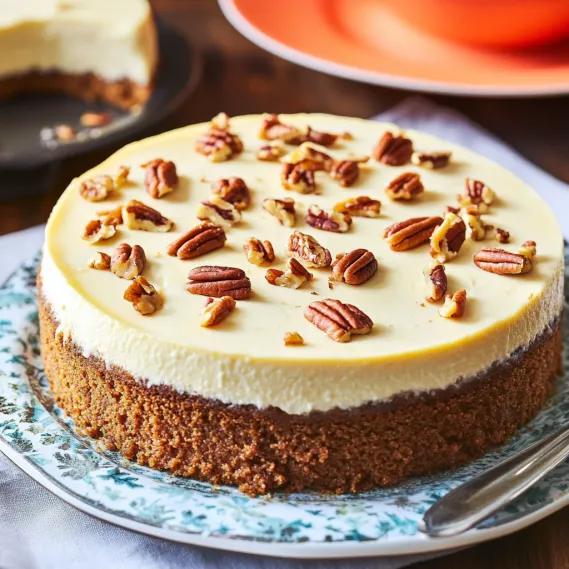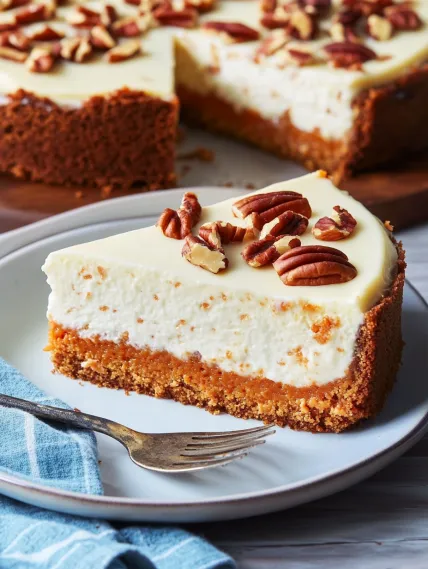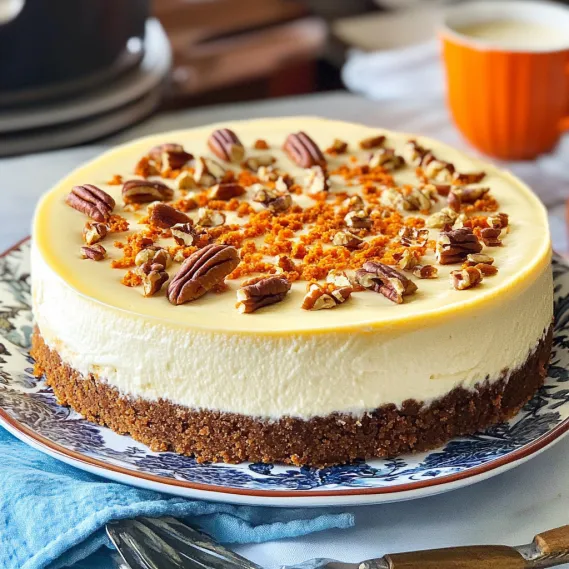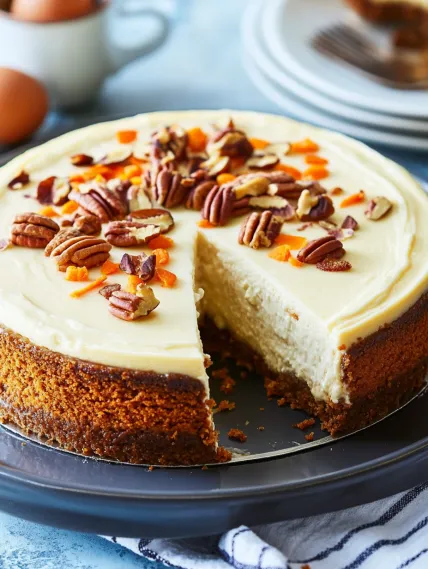 Pin it
Pin it
This stunning Carrot Cake Cheesecake delivers the best of both worlds – a moist, spiced carrot cake base topped with a silky-smooth layer of classic vanilla cheesecake. Each slice reveals beautiful distinct layers that combine the homey comfort of carrot cake with the luxurious richness of cheesecake. The genius par-baking technique ensures perfect texture in both layers, while chopped pecans add delightful crunch throughout the carrot layer and make a beautiful decorative border. This show-stopping dessert satisfies both carrot cake lovers and cheesecake enthusiasts, making it the ultimate compromise-free spring dessert.
I first brought this cake to our family's Easter gathering, where the usual dessert debate (carrot cake vs. cheesecake) had become a yearly tradition. My aunt, the dedicated carrot cake fan, and my cousin, the devoted cheesecake lover, both declared this the perfect solution. Now it's requested by name every spring, and I've been asked to share the recipe dozens of times!
Essential Ingredients and Selection Tips
- Carrots: Freshly grated carrots provide the best moisture and flavor; pre-shredded ones are often too dry.
- Cream Cheese: Use full-fat, brick-style cream cheese at true room temperature for the smoothest cheesecake layer.
- Pecans: Toast them before chopping to enhance their nutty flavor. Reserve some perfect halves for decoration.
- Canola Oil: Creates a moister carrot cake than butter would; any neutral oil works well.
- Sour Cream: Adds tanginess and creates a silkier cheesecake texture. Full-fat produces the best results.
I've found that the quality of your carrots makes a significant difference in this recipe. Fresh, organic carrots grated just before baking provide the most moisture and sweetest flavor. Save time by using a food processor with a grating attachment rather than pre-shredded carrots, which can be dry and lacking in flavor.
Detailed Cooking Instructions
- Step 1: Prepare The Perfect Carrot Base
- Preheat oven to 350°F and spray a 9-inch springform pan with cooking spray. In a large bowl, whisk 1 cup sugar, 1/3 cup oil, and 2 eggs until smooth. In a separate bowl, combine 1 cup flour, 3/4 teaspoon baking powder, 1/2 teaspoon each of baking soda and cinnamon, and 1/4 teaspoon salt. Mix wet and dry ingredients together, then fold in 1 cup finely grated carrots and 3/4 cup chopped toasted pecans.
- Step 2: Master The Par-Baking Method
- Spread the carrot batter evenly in the prepared pan and bake until edges are just set and the top is no longer shiny, about 18 minutes. The center will still be slightly underdone, which is perfect. Cool for 30 minutes while preparing the cheesecake layer and reducing oven temperature to 325°F.
- Step 3: Create Silky Cheesecake Topping
- Beat 16 ounces room-temperature cream cheese until completely smooth, about 2 minutes. Gradually add 1/2 cup each of sour cream and sugar, plus 1 tablespoon flour and 1/4 teaspoon salt, beating until smooth and creamy. Add 2 eggs one at a time, mixing just until incorporated after each. Stir in 2 teaspoons vanilla extract until fully combined.
- Step 4: Combine The Two Layers
- Pour the cheesecake batter slowly and carefully over the cooled carrot cake layer, starting at the outer edges and working toward the center. This technique prevents the carrot cake from rising into the cheesecake layer or sinking in the middle. Place the springform pan on a rimmed baking sheet to catch any potential leaks.
- Step 5: Bake And Cool With Patience
- Bake at 325°F until edges are set but center still jiggles slightly when pan is shaken, 50-55 minutes. Cool completely on a wire rack for about 2 hours, then cover and refrigerate at least 8 hours or overnight. Before serving, run a knife around the edges, remove springform ring, and decorate the perimeter with pecan halves.
 Pin it
Pin it
My first attempt at this recipe resulted in the carrot cake layer rising into the cheesecake during baking. I've since learned that pouring the cheesecake batter slowly from the edges inward, and ensuring the carrot cake is properly cooled, prevents this problem completely. Now my layers are perfectly distinct every time!
The Secret To Perfect Wok Technique
High heat is essential for authentic fried rice. My grandmother taught me to heat the wok until smoking before adding oil. Keep ingredients moving constantly to achieve that elusive "wok hei" flavor. Never overcrowd the pan—cook in batches instead. This technique transformed my fried rice into restaurant-quality perfection.
 Pin it
Pin it
Making The Most Of Leftovers
This dish excels at transforming leftovers into something exciting. I've used roast chicken, holiday ham, and even Thanksgiving turkey with great success. Cut meat into uniform pieces that distribute evenly throughout. Leftover grilled steak adds incredible depth with its smoky edges. Even roasted vegetables bring delightful caramelized sweetness.
Balancing Flavors And Textures
Special fried rice succeeds through balanced components. Char siu provides richness, prawns add sweetness, eggs contribute silkiness, while vegetables offer freshness. The sequence matters—aromatics first build flavor, eggs midway remain distinct, vegetables maintain crispness. Adding spring onions last preserves their brightness for that authentic restaurant finish.
Customization For Dietary Needs
This dish adapts easily to dietary restrictions. For vegetarians, I omit meat, double eggs and add extra vegetables. Low-carb diners enjoy my cauliflower rice version that carries flavors beautifully. For gluten-sensitive guests, tamari replaces soy sauce while ensuring chicken powder is certified gluten-free. Everyone enjoys this beloved dish regardless of restrictions.
Seasonal Variations Worth Trying
While the classic version is perfect for spring, I've created seasonal adaptations that have become family favorites. For summer, I add a teaspoon of orange zest to the carrot cake layer and decorate with candied orange peel. Come fall, I incorporate a half teaspoon of pumpkin pie spice into the carrot layer and garnish with toasted pepitas instead of pecans. During winter holidays, I add a quarter teaspoon of ground ginger to the carrot cake and decorate with crystallized ginger pieces alongside the pecans. These simple variations keep this showstopper fresh and exciting throughout the year.
Make-Ahead Strategies For Entertaining
One of the greatest advantages of this dessert is its make-ahead potential, which I've leveraged for numerous gatherings. The cake actually improves with time as the flavors meld, making it ideal for preparing in advance. For holiday meals, I often bake it two days before the event, keeping it in the springform pan, covered, in the refrigerator. I wait to remove the ring and add the pecan decoration until shortly before serving. For transporting to potlucks, I leave it in the springform base but remove the ring, which makes it easier to slice once I arrive. The sturdy nature of both layers means it travels beautifully without damage.
Troubleshooting Common Issues
Through many iterations of this recipe, I've encountered and solved several potential problems. If your cheesecake layer cracks, it was likely baked too long or cooled too quickly – next time, turn off the oven and let it cool inside with the door ajar for an hour. If your carrot cake layer rises too much into the cheesecake, ensure it's properly cooled before adding the cheesecake batter, and pour the batter more slowly around the edges first. If your cheesecake batter has lumps, your cream cheese wasn't soft enough – placing the foil-wrapped blocks in warm water for 15 minutes solves this issue. These simple adjustments have helped me achieve perfect results consistently.
 Pin it
Pin it
This Carrot Cake Cheesecake has become my signature springtime dessert, requested for everything from Easter celebrations to spring birthdays. The combination of homey carrot cake with sophisticated cheesecake creates something greater than the sum of its parts – a dessert that manages to feel both special-occasion worthy and comfortingly familiar at the same time. While it might look like it came from a professional bakery, the straightforward techniques make it achievable for any home baker willing to exercise a little patience during the cooling and chilling process.
Frequently Asked Questions
- → Can I use pre-shredded carrots for this recipe?
- It's best to use freshly grated carrots for this recipe rather than pre-shredded ones from the store. Pre-shredded carrots are often dry and thicker than freshly grated, which affects both the moisture and texture of the carrot cake layer. Take the extra few minutes to peel and grate your own carrots using the fine side of a box grater - you'll notice the difference in the final texture and moisture of the cake.
- → Why is my cheesecake cracking on top?
- Cheesecake cracks usually occur from one of these reasons: 1) Overbeating the eggs, which incorporates too much air - mix eggs in just until combined; 2) Baking at too high a temperature - make sure your oven is correctly calibrated; 3) Opening the oven door during baking, causing temperature fluctuations; or 4) Not allowing the cheesecake to cool gradually - leave it in the turned-off oven with the door cracked open for 30 minutes after baking, then cool at room temperature. If cracks do appear, don't worry - the pecan topping will cover them beautifully!
- → Can I make this dessert ahead of time?
- Yes, this is an excellent make-ahead dessert! In fact, it needs at least 8 hours of chilling time, but can be made up to 3 days in advance. Keep it in the springform pan in the refrigerator, covered tightly with plastic wrap. Only remove the sides of the pan and add the pecan decoration shortly before serving. This actually improves the flavor as it gives the cake and cheesecake time to meld together.
- → What can I substitute for pecans if I have a nut allergy?
- If you have a nut allergy, you can simply omit the pecans entirely for a nut-free version. To replace the texture and flavor they provide, consider adding 1/2 cup of golden raisins or dried cranberries to the carrot cake batter. For decoration on top, you could use carrot curls (made with a vegetable peeler), crushed graham crackers, or white chocolate shavings instead of the chopped pecans.
- → How do I know when the cheesecake is properly baked?
- A perfectly baked cheesecake should still have a slight jiggle in the center when the pan is gently shaken - similar to how set Jell-O jiggles. The edges should appear more set than the center (about 2-3 inches from the edge should be stable). If the entire cheesecake is completely firm with no movement, it's likely overbaked. Remember that it will continue to set as it cools and chills. Using a water bath can help ensure even baking, though this recipe doesn't require one.
- → Can I freeze this carrot cake cheesecake?
- Yes, this dessert freezes beautifully for up to 3 months. After it has completely chilled in the refrigerator, remove it from the springform pan and place on a cardboard round. Wrap the whole cheesecake (or individual slices) tightly in plastic wrap, then in aluminum foil. To thaw, transfer to the refrigerator for at least 12 hours before serving. Add the pecan decoration after thawing for the best appearance. Freezing can actually improve the texture, making the cheesecake even creamier when thawed.
